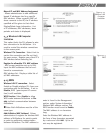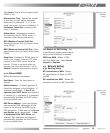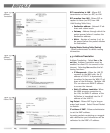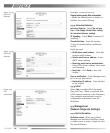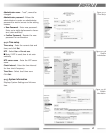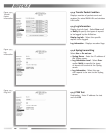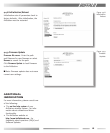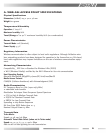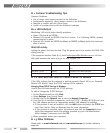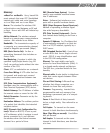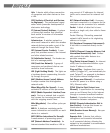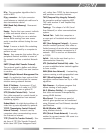
24
25
Hub: A device which allows connection
of computers and other devices to form
a LAN.
IEEE (Institute of Electrical and Electron-
ics Engineers): The professional organi-
zation which promotes development of
electronics technology.
IP (Internet Protocol) Address: A unique
32-binary-digit number that identies
each sender or receiver of information
sent in packets.
Infrastructure: A wireless network or
other small network in which the wireless
network devices are made a part of the
network through the Access Point.
ISP (Internet Service Provider): A com-
pany that provides access to the Internet
and other related services.
IV (Initialization Vector): The header sec-
tion of a message packet.
LAN (Local Area Network): A group of
computers and peripheral devices con-
nected to share resources.
LED (Light Emitting Diode): The lights on
a hardware device representing the activ-
ity through the ports.
MAC (Medium Access Control) Address:
A unique number that distinguishes
network cards.
Mbps (Mega Bits Per Second): A mea-
surement of millions of bits per second.
MDI/X (Media Dependent Interface/Cross-
over): Port on a network hub or switch
that crosses the incoming transmit lines
with the outgoing receive lines.
MHz (MegaHertz): One million cycles per
second.
MIB II: A database containing perfor-
mance information and statistics on each
device in a network.
MIPS (Million Instructions Per Second):
A measurement of processing speed.
NAT (Network Address Translation): An
internet standard that enables a LAN to
use one set of IP addresses for internal
trafc and a second set for external traf-
c.
NIC (Network Interface Card): An expan-
sion card connected to a computer so the
computer can be connected to a network.
Packet: A block of data that is trans-
ferred as a single unit, also called a frame
or a block.
Packet Filtering: Discarding unwanted
network trafc based on its originating
address or its type.
PCI (Peripheral Component Interconnect):
A bus that is connected directly to the
CPU.
PCMCIA (Personal Computer Memory Card
International Association) Card: Remov-
able module that adds features to a
portable computer.
Ping (Packet Internet Groper): An Internet
utility used to determine whether a par-
ticular IP address is online.
Plug and Play: Hardware that, once in-
stalled (“plugged in”), can immediately be
used (“played”), as opposed to hardware
that requires manual conguration.
PoE (Power over Ethernet): A mechanism
to send DC power to a device using a
CAT5 Ethernet cable.
PPPoE (Point-to-Point Protocol over
Ethernet): A specication for connecting
users on an Ethernet line to the Internet
through a common broadband medium.
Protocol: A standard way of exchanging
information between computers.
RADIUS (Remote Authentication Dial In
User Service): A server that issues au-
thentication key to clients.
RAM (Random Access Memory): Non-per-
manent memory.
Repeater Hub: A device that collects,
strengthens and transmits information
to all connected devices, allowing the
network to be extended to accommodate
additional workstations.




